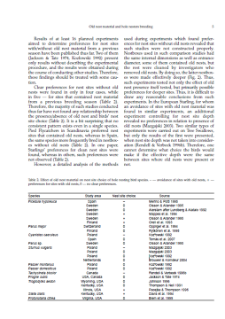- Wyszukaj w całym Repozytorium
- Piśmiennictwo i mapy
- Archeologia
- Baza Młynów
- Nauki przyrodnicze
Wyszukiwanie zaawansowane
Wyszukiwanie zaawansowane
Wyszukiwanie zaawansowane
Wyszukiwanie zaawansowane
Wyszukiwanie zaawansowane

Obiekt
Tytuł: Dispersion Asymmetry within a Feral Pigeon Columba livia Population
Inny tytuł:
Asymetria dyspersji w populacji gołębia miejskiego ; Dispersion in the Feral Pigeon
Współtwórca:
Museum and Institute of Zoology, Polish Academy of Sciences
Wydawca:
Museum and Institute of Zoology, Polish Academy of Sciences ; Natura Optima Dux Foundation
Miejsce wydania:
Opis:
Typ obiektu:
Abstrakt:
The aim of the study was to determine the pattern of dispersion in Feral Pigeons, as well as the factors influencing the degree of dispersion. Aside from studying variation in dispersion among the bird colonies, the direction and distance of dispersion were also analysed. The results of the study point unequivocally to strong dispersion asymmetry in the population, which is mainly age-biased. There were great differences in dispersion between adult (reproducing) individuals and young individuals that had not yet joined the breeding population. Each year, young individuals which had permanently left their natal colonies accounted for 20–30% of the young birds that ultimately joined the breeding population. The insignificant degree of dispersion among adult birds (from 0 to 0.8% per year) was due to their strong philopatry towards their breeding sites. A lack of reproductive success did not have any effect on dispersion in the case of the breeding pairs studied. A factor conducive to a bird's departure from the natal colony was the high density of breeding pairs present in the colony. It was found that the direction of dispersion was from a colony with a higher density to a colony with a lower density of pigeons. The Feral Pigeons did not emigrate to join colonies of domestic pigeons kept on the outskirts of the city, nor did they emigrate to other towns in the neighbourhood of the study area (Słupsk, NW Poland). The time when young birds left the natal colony did not influence the degree of their dispersion. Young birds that left their natal colony experienced significantly higher breeding success in their new colony, compared to those young birds that remained in the natal colony, where the density of breeding pairs was high. Young females dispersed more often than young males, although this difference was not statistically significant. This article also discusses the dispersion mechanism in the case of young pigeons.
Czasopismo/Seria/cykl:
Tom:
Zeszyt:
Strona pocz.:
Strona końc.:
Szczegółowy typ zasobu:
Format:
Identyfikator zasobu:
oai:rcin.org.pl:55629 ; 10.3161/068.042.0109
Źródło:
MiIZ PAN, sygn. P.257 ; MiIZ PAN, sygn. P.4568
Język:
Język streszczenia:
Prawa:
Prawa zastrzeżone - dostęp nieograniczony
Zasady wykorzystania:
Digitalizacja:
Muzeum i Instytut Zoologii Polskiej Akademii Nauk
Lokalizacja oryginału:
Biblioteka Muzeum i Instytutu Zoologii PAN
Dofinansowane ze środków:
Program Operacyjny Innowacyjna Gospodarka, lata 2010-2014, Priorytet 2. Infrastruktura strefy B + R ; Unia Europejska. Europejski Fundusz Rozwoju Regionalnego
Dostęp:
Kolekcje, do których przypisany jest obiekt:
- Repozytorium Cyfrowe Instytutów Naukowych > Kolekcje Partnerów > Muzeum i Instytut Zoologii PAN > Czasopisma
- Repozytorium Cyfrowe Instytutów Naukowych > Kolekcje Partnerów > Muzeum i Instytut Zoologii PAN > Wydawnictwa MiIZ PAN > Acta Ornithologica
- Repozytorium Cyfrowe Instytutów Naukowych > Piśmiennictwo > Czasopisma/Artykuły
Data ostatniej modyfikacji:
4 lut 2025
Data dodania obiektu:
29 lip 2015
Liczba pobrań / odtworzeń:
42
Wszystkie dostępne wersje tego obiektu:
https://rcin.org.pl./publication/75702
Wyświetl opis w formacie RDF:
Wyświetl opis w formacie RDFa:
Wyświetl opis w formacie OAI-PMH:
| Nazwa wydania | Data |
|---|---|
| Dispersion Asymmetry within a Feral Pigeon Columba livia Population / Hetmański, Tomasz | 4 lut 2025 |
Obiekty Podobne
Hetmański, Tomasz Polska Akademia Nauk. Muzeum i Instytut Zoologii
Dabert, Jacek

 INSTYTUT ARCHEOLOGII I ETNOLOGII POLSKIEJ AKADEMII NAUK
INSTYTUT ARCHEOLOGII I ETNOLOGII POLSKIEJ AKADEMII NAUK
 INSTYTUT BADAŃ LITERACKICH POLSKIEJ AKADEMII NAUK
INSTYTUT BADAŃ LITERACKICH POLSKIEJ AKADEMII NAUK
 INSTYTUT BADAWCZY LEŚNICTWA
INSTYTUT BADAWCZY LEŚNICTWA
 INSTYTUT BIOLOGII DOŚWIADCZALNEJ IM. MARCELEGO NENCKIEGO POLSKIEJ AKADEMII NAUK
INSTYTUT BIOLOGII DOŚWIADCZALNEJ IM. MARCELEGO NENCKIEGO POLSKIEJ AKADEMII NAUK
 INSTYTUT BIOLOGII SSAKÓW POLSKIEJ AKADEMII NAUK
INSTYTUT BIOLOGII SSAKÓW POLSKIEJ AKADEMII NAUK
 INSTYTUT CHEMII FIZYCZNEJ PAN
INSTYTUT CHEMII FIZYCZNEJ PAN
 INSTYTUT CHEMII ORGANICZNEJ PAN
INSTYTUT CHEMII ORGANICZNEJ PAN
 INSTYTUT FILOZOFII I SOCJOLOGII PAN
INSTYTUT FILOZOFII I SOCJOLOGII PAN
 INSTYTUT GEOGRAFII I PRZESTRZENNEGO ZAGOSPODAROWANIA PAN
INSTYTUT GEOGRAFII I PRZESTRZENNEGO ZAGOSPODAROWANIA PAN
 INSTYTUT HISTORII im. TADEUSZA MANTEUFFLA POLSKIEJ AKADEMII NAUK
INSTYTUT HISTORII im. TADEUSZA MANTEUFFLA POLSKIEJ AKADEMII NAUK
 INSTYTUT JĘZYKA POLSKIEGO POLSKIEJ AKADEMII NAUK
INSTYTUT JĘZYKA POLSKIEGO POLSKIEJ AKADEMII NAUK
 INSTYTUT MATEMATYCZNY PAN
INSTYTUT MATEMATYCZNY PAN
 INSTYTUT MEDYCYNY DOŚWIADCZALNEJ I KLINICZNEJ IM.MIROSŁAWA MOSSAKOWSKIEGO POLSKIEJ AKADEMII NAUK
INSTYTUT MEDYCYNY DOŚWIADCZALNEJ I KLINICZNEJ IM.MIROSŁAWA MOSSAKOWSKIEGO POLSKIEJ AKADEMII NAUK
 INSTYTUT PODSTAWOWYCH PROBLEMÓW TECHNIKI PAN
INSTYTUT PODSTAWOWYCH PROBLEMÓW TECHNIKI PAN
 INSTYTUT SLAWISTYKI PAN
INSTYTUT SLAWISTYKI PAN
 SIEĆ BADAWCZA ŁUKASIEWICZ - INSTYTUT TECHNOLOGII MATERIAŁÓW ELEKTRONICZNYCH
SIEĆ BADAWCZA ŁUKASIEWICZ - INSTYTUT TECHNOLOGII MATERIAŁÓW ELEKTRONICZNYCH
 MUZEUM I INSTYTUT ZOOLOGII POLSKIEJ AKADEMII NAUK
MUZEUM I INSTYTUT ZOOLOGII POLSKIEJ AKADEMII NAUK
 INSTYTUT BADAŃ SYSTEMOWYCH PAN
INSTYTUT BADAŃ SYSTEMOWYCH PAN
 INSTYTUT BOTANIKI IM. WŁADYSŁAWA SZAFERA POLSKIEJ AKADEMII NAUK
INSTYTUT BOTANIKI IM. WŁADYSŁAWA SZAFERA POLSKIEJ AKADEMII NAUK




































